When I first built the Stanford MBA acceptance rate model, it showed that GPA had little to no impact on acceptance rate. I have reevaluated the data and now I believe that GPA does matter when applying to Stanford. Although GPA has an impact on acceptance, GMAT is still more important for Stanford MBA admissions.
Stanford MBA Acceptance Rate by GMAT
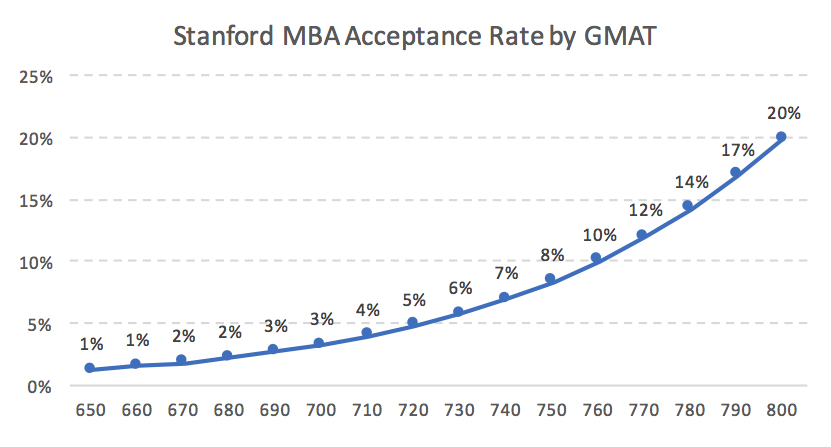 GMAT is very important when applying to Stanford’s business school. When an applicant increases their GMAT by 100 points, from 650 to 750, they increase their chance of admission 8 fold. Average GMAT is over 730 points, which means an applicant must have a GMAT north of 750 for an acceptance rate in the double digits.
GMAT is very important when applying to Stanford’s business school. When an applicant increases their GMAT by 100 points, from 650 to 750, they increase their chance of admission 8 fold. Average GMAT is over 730 points, which means an applicant must have a GMAT north of 750 for an acceptance rate in the double digits.
Stanford MBA Acceptance Rate by GPA
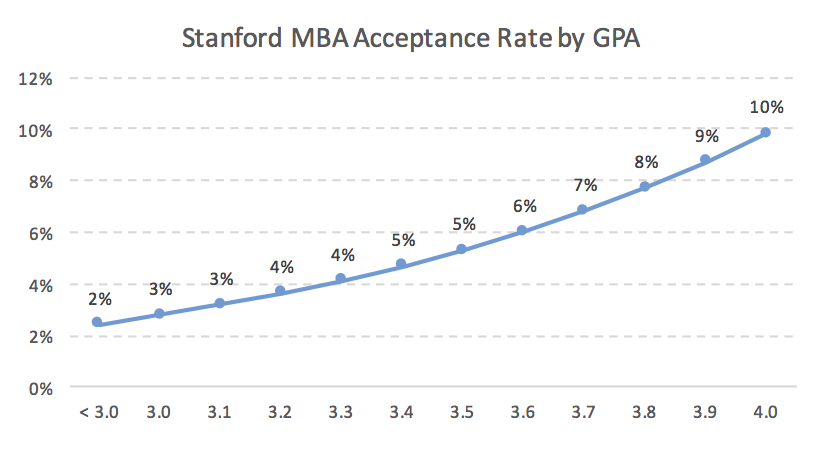 My new analysis demonstrates that GPA is actually important when applying to Stanford GSB. The average GPA of a Stanford applicant is 3.56. Each “.10” increase in GPA raises acceptance rate at Stanford by approximately 1%.
My new analysis demonstrates that GPA is actually important when applying to Stanford GSB. The average GPA of a Stanford applicant is 3.56. Each “.10” increase in GPA raises acceptance rate at Stanford by approximately 1%.
Stanford MBA Acceptance Rate GMAT vs. GPA
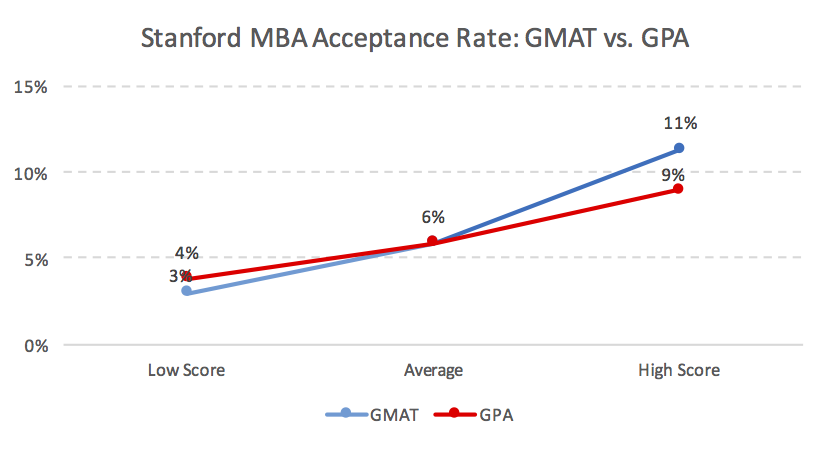 Although both GMAT and GPA are important factors that influence an applicant’s chance of admission to Stanford Graduate School of Business, GMAT is more important than GPA. A high GMAT increases acceptance rate at Stanford by 5%*. On the other hand, a high GPA only increase acceptance rate by 3%.
Although both GMAT and GPA are important factors that influence an applicant’s chance of admission to Stanford Graduate School of Business, GMAT is more important than GPA. A high GMAT increases acceptance rate at Stanford by 5%*. On the other hand, a high GPA only increase acceptance rate by 3%.
I was not happy with the original predictive model I built for Stanford. I updated my methodology for building the model, mainly in the way I cleaned the data. The results above represent my new model. Below I compare the performance of the old and new model. In order to evaluate performance, I grouped applicants into buckets based on their predicted acceptance rate, then looked at the actual acceptance rate was for that group. The X-axis is the predicted acceptance grouping and the Y-axis is the actual acceptance rate.
Original Stanford MBA Model Performance
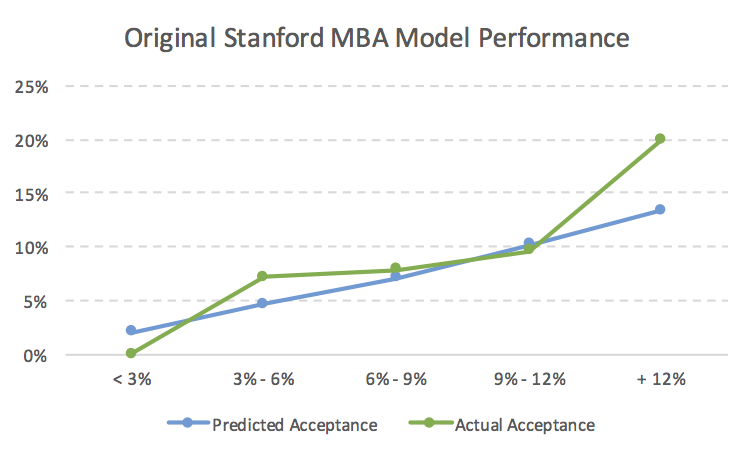 Although the graph above looks like it does a good job of predicting the acceptance rate at Stanford. The results are deceptive because almost all of the population fall into the 3% – 6% or 6% – 9% groups, which have little separation.
Although the graph above looks like it does a good job of predicting the acceptance rate at Stanford. The results are deceptive because almost all of the population fall into the 3% – 6% or 6% – 9% groups, which have little separation.
New Stanford MBA Model Performance
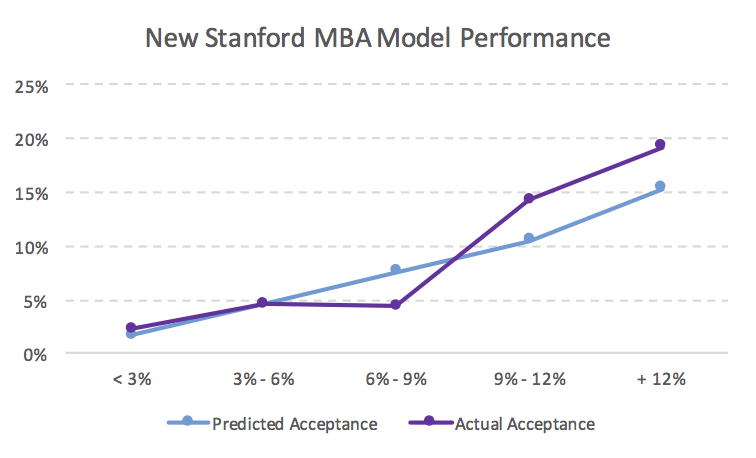 The new model clearly shows significant differentiation, with the exception of the 6% – 9% group. The biggest problem is that the 6% – 9% group has an acceptance rate that is over estimated and the above 9% population is under estimated. The main difference between the original model and new model is the distribution of predictions seen below.
The new model clearly shows significant differentiation, with the exception of the 6% – 9% group. The biggest problem is that the 6% – 9% group has an acceptance rate that is over estimated and the above 9% population is under estimated. The main difference between the original model and new model is the distribution of predictions seen below.
Stanford MBA Model Distribution: New vs. Old
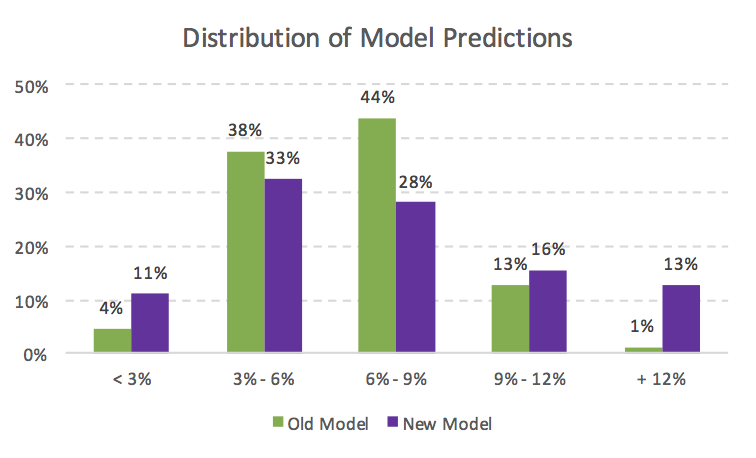 In the original model, 82% of all applicants fell into the 3% to 9% range with only 5% of applicants below 3% or above 12%. The new model has a much more even distribution of applicants. The number of low and high acceptance rate applicants has increased from 5% to 24%.
In the original model, 82% of all applicants fell into the 3% to 9% range with only 5% of applicants below 3% or above 12%. The new model has a much more even distribution of applicants. The number of low and high acceptance rate applicants has increased from 5% to 24%.
Data used to create this post came from GMAT Club, which is one of the best websites for preparing for the GMAT.
*A high GMAT or high GPA is defined as one standard deviation above average. A low score is defined as one standard deviation below.
